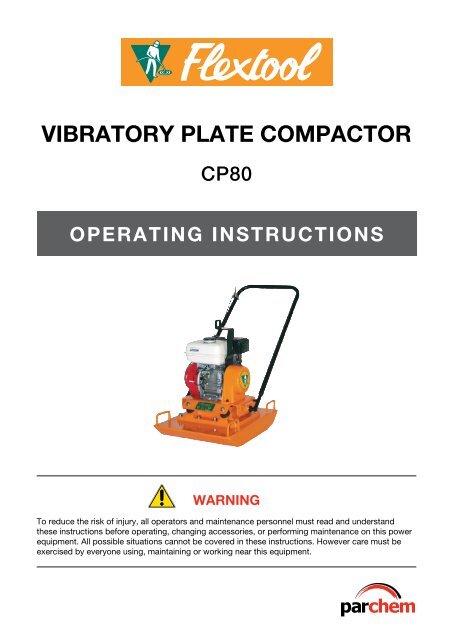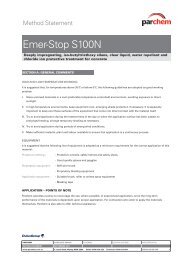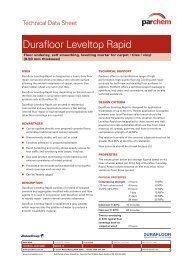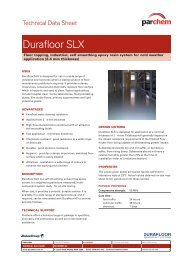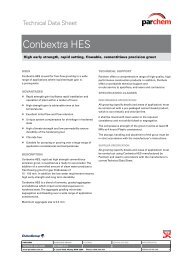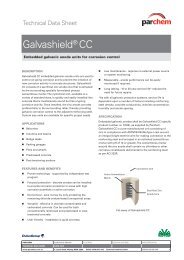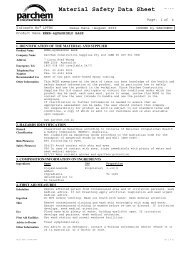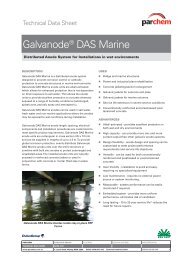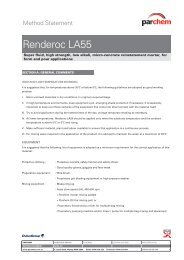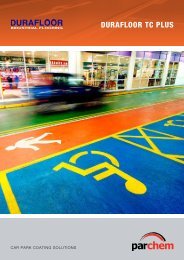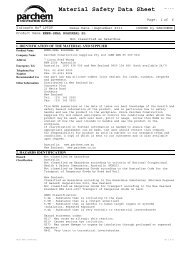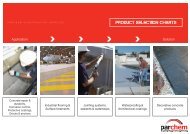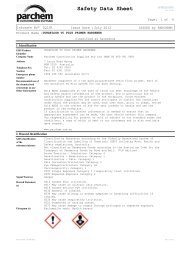Operating Instructions - Flextool CP80 - Parchem
Operating Instructions - Flextool CP80 - Parchem
Operating Instructions - Flextool CP80 - Parchem
- No tags were found...
You also want an ePaper? Increase the reach of your titles
YUMPU automatically turns print PDFs into web optimized ePapers that Google loves.
VIBRATORY PLATE COMPACTOR<br />
<strong>CP80</strong><br />
OPERATING INSTRUCTIONS<br />
WARNING<br />
To reduce the risk of injury, all operators and maintenance personnel must read and understand<br />
these instructions before operating, changing accessories, or performing maintenance on this power<br />
equipment. All possible situations cannot be covered in these instructions. However care must be<br />
exercised by everyone using, maintaining or working near this equipment.
Contents<br />
Introduction 2<br />
Applications 2<br />
Functions and controls 2<br />
Hazards & risks 2-3<br />
Operation 3<br />
Care and preventive maintenance 3<br />
Service 3<br />
Specifications 3<br />
Trouble shooting 4<br />
Spare parts and service 4<br />
INTRODUCTION<br />
Thank you for your selection of <strong>Parchem</strong> equipment. <strong>Parchem</strong> have<br />
specialised in the design and manufacture of quality products since<br />
1951.<br />
We have taken care in the design, manufacture and testing of this<br />
product. Should service or spare parts be required, prompt and<br />
efficient service is available from our branches.<br />
General Safety <strong>Instructions</strong> for the Operation of Power Equipment<br />
The goal of <strong>Parchem</strong> is to produce power equipment that helps<br />
the operator work safely and efficiently. The most important safety<br />
device for this or any tool is the operator. Care and good judgement<br />
are the best protection against injury.<br />
All possible hazards cannot be covered here however we have<br />
tried to highlight some of the important items. Individuals should<br />
look for and obey Caution, Warning and Danger signs placed on<br />
equipment, and displayed in the workplace. Operators MUST<br />
read and follow safety instructions packed with each product and<br />
complete there own work method statement and JSEA<br />
Learn how each machine works. Even if you have previously used<br />
similar machines, carefully check out each machine before you use<br />
it. Get the “feel” of it and know its capabilities, limitations, potential<br />
hazards, how it operates, and how it stops.<br />
APPLICATIONS<br />
• Trench compaction<br />
• Earthworks<br />
• Road maintenance<br />
• Landscaping<br />
• Brick paving<br />
• Driveway toppings<br />
FUNCTIONS AND CONTROLS<br />
Motor<br />
The rnotor is controlled by an ON/OFF switch or push button which<br />
is mounted on the motor below the fuel tank.<br />
The motor speed is controlled by a remote throttle lever which is<br />
mounted on the machine handle.<br />
Honda motors are fitted with an oil alert device which will stop the<br />
motor or prevent starting when the crankcase oil level falls below a<br />
safe level.<br />
Drive belt<br />
Tension of the drive belt is adjustable. Loosen the four nuts on<br />
the bolts which secure the motor to the base plate, Adjust the set<br />
screws which bear against the motor crankcase to achieve the<br />
required belt tension. Ensure that the four nuts and the set screw<br />
locknuts are tightened after adjustment.<br />
HAZARDS AND RISKS<br />
NEVER allow any person to operate the machine without adequate<br />
instruction, SWMS, JSEA and competency validation.<br />
ENSURE all operators read, understand and follow the operating<br />
instructions.<br />
SERIOUS INJURY may result from improper or careless use of this<br />
machine.<br />
Plate compactors are heavy units and should be positioned by two<br />
people of appropriate strength using the lifting handles provided on<br />
the machine, along with correct lifting techniques.<br />
! MECHANICAL HAZARDS<br />
DO NOT operate the machine unless all protective guards are in<br />
place. Ensure all warning labels are visible and understood.<br />
KEEP hands and feet clear of rotating and moving parts as they will<br />
cause injury if contacted.<br />
ENSURE that the motor operation switch is in the OFF position and<br />
the spark plug ignition lead is disconnected before removing the<br />
guards or making adjustments.<br />
ENSURE both the machine and the operator are stable by setting<br />
up on level terrain and the machine will not tip over, slide or fall<br />
while in operation or unattended.<br />
DO NOT leave the machine in operation while it is unattended.<br />
ENSURE that the walls of a trench are stable and will not collapse<br />
due to the action of the vibration, prior to commencing compaction.<br />
ENSURE that the area to be compacted does not contain any “live”<br />
electrical cables, gas, water or communication services which may<br />
be damaged by the action of the vibration.<br />
EXERCISE CARE when operating unit. Exposure to vibration or<br />
repetitive work actions may be harmful to hands and arms.<br />
NEVER stand on the unit while it is operating.<br />
DO NOT increase the governed no-load motor speed above 3,500<br />
rpm. Any increase may result in personal injury and damage to the<br />
machine.<br />
BE CAREFUL not to come in contact with the muffler when the<br />
engine is hot, since it can cause severe burns.<br />
ENSURE that repairs to the motor and machine are carried out by<br />
qualified COMPETENT personnel.<br />
! FIRE & EXPLOSION HAZARDS<br />
PETROL or diesel is extremely flammable and explosive under<br />
certain conditions.<br />
ENSURE that petrol or diesel is only stored in an approved storage<br />
container away from source of ignition.<br />
DO NOT refuel the motor while it is in operation or hot.<br />
DO NOT refuel the motor in the vicinity of ignition source such as<br />
sparks, a naked flame or a person smoking.<br />
DO NOT over fill the fuel tank and avoid spilling petrol when<br />
refuelling. Spilled petrol or petrol vapour may ignite. If spillage<br />
occurs, ensure that the area is dry before starting the motor.<br />
ENSURE that the fuel tank cap is securely fitted after refuelling.<br />
Ensure fire extinguisher is readily available for use.<br />
2
! CHEMICAL HAZARDS<br />
DO NOT operate or refuel a petrol or diesel motor in a confined area<br />
without adequate ventilation.<br />
CARBON MONOXIDE exhaust gases from internal combustion<br />
motor driven units can cause death in confined spaces.<br />
Check TLV (Threshold Limit Value) and oxygen content of area safe<br />
for operation.<br />
! NOISE HAZARDS<br />
EXCESSIVE NOISE can lead to temporary or permanent loss of<br />
hearing.<br />
WEAR an approved hearing protection device to limit noise<br />
exposure as required by Occupational Health and Safety regulations<br />
suitable for machine noise Ievels.<br />
PROTECTIVE CLOTHING<br />
ALWAYS wear approved hearing protection, protective goggles and<br />
a dust mask when working in a dusty environment.<br />
Protective clothing, anti-vibration gloves, safety footwear must be<br />
worn especially when working with hot mix bitumen. Wear sun<br />
cream and wide brimmed hat in exposed areas. Drink plenty of<br />
water.<br />
! additional HAZARDS<br />
Vibration hazard can cause permanent injury SliplTrip/Fall is a major<br />
cause of serious injury or death.<br />
Beware of uneven or slippery work surfaces.<br />
Exercise care when working in the vicinity of unprotected holes<br />
elevated platforms or excavations.<br />
OPERATION<br />
The machine is best suited to the compaction of bituminous and<br />
granular materials e.g. granular soils, gravels and sands or mixtures<br />
of both, Cohesive soils such as silt and clay are best compacted<br />
using the impact force produced by a vibrating rammer.<br />
Where possible the site should be graded and levelled before<br />
commencing compaction.<br />
Correct moisture content in soil is vital to proper compaction.<br />
Water acts as a lubricant to help slide soil particles together.<br />
Too little moisture means inadequate compaction; too much<br />
moisture leaves water’filled voids that weaken the soil’s loadbearing<br />
ability. Compaction of dry materials will be facilitated by moistening<br />
with a water hose fitted with a sprinkler.<br />
Excessive watering or water content will cause the machine to stall.<br />
The optional water tank kit is recommended when the machine is<br />
used on bituminous surfaces as the water film prevents a build-up<br />
of material on the underside of the plate.<br />
Use unleaded grade petrol and ensure that the fuel is free from<br />
contamination.<br />
The vibratory motion provides a self-propelling action.<br />
Position the handle at the opposite end of the machine to the<br />
vibrator.<br />
Start the motor using the recoil starter. (If the motor is fitted with an<br />
on/off switch this must first be turned to ON before starting.)<br />
For more information on starting and correct operating procedures<br />
of the motor, refer to the motor operation manual supplied with the<br />
unit.<br />
Increase the motor speed to the maximum setting using the hand<br />
throttle lever, before commencing compacting.<br />
The machine should be controlled by grasping the handle with both<br />
hands and applying restraint to control the forward motion,<br />
Steer the machine by moving the handle sideways to the right or<br />
left. Ensure other persons and children are clear of barricaded area.<br />
Keep clear of electrical leads and hoses on floor.<br />
ALWAYS maintain good footing so that you do not slip and loose<br />
control when starting or operating the machine.<br />
If the optional water tank is fitted, the flow rate can be controlled by<br />
adjusting the cock in the supply hose to the sprinkler bar.<br />
CARE AND PREVENTIVE MAINTENANCE<br />
Check the oil level in the motor crankcase daily.<br />
Inspect the rubber anti vibration mounts for wear or deterioration.<br />
If the optional water tank is fitted inspect the water hose and its<br />
connections to ensure that they do not leak.<br />
Clean the underside of the plate regularly to prevent a build-up of<br />
material.<br />
SERVICE<br />
Change the oil in the motor crankcase regularly to minimise wear.<br />
Inspect, clean and/or replace the motor air cleaner regularly,<br />
particularly when operating in a dusty environment.<br />
Inspect, clean and/or replace the spark plug regularly.<br />
Check all fasteners for tightness as the machine is subject to<br />
vibration.<br />
Check vee belt tension, wear and that it is running true, adjust or<br />
replace as required.<br />
specifications<br />
MOTOR<br />
Honda GX160<br />
Governed speed 3,500 r/min.<br />
WEIGHT<br />
<strong>CP80</strong><br />
77Kg<br />
SHIPPING<br />
Size (I x w x h) 630 mm x 495 mm x 1165 mm<br />
DRIVE BELTS<br />
1 x ‘A’ section vee belt<br />
VIBRATOR<br />
Frequency -5,800 vibrationslmin<br />
Centrifugal force - 19.8 kN<br />
BEARINGS<br />
The following bearings are sealed:<br />
Centrifugal clutch - grease lubricated<br />
Vibrator - oil bath lubricated<br />
FINISH<br />
The machine is finished in gold equipment enamel, the handle in<br />
black baked enamel. Exposed metal surfaces are zinc electroplated<br />
for corrosion protection.<br />
3
TROUBLESHOOTING<br />
SYMPTOM<br />
Motor will not start<br />
Motor stops<br />
Petrol<br />
Motor lacks power<br />
Insufficient vibration<br />
Machine not moving freely<br />
POSSIBLE CAUSES AND CORRECTION<br />
• Check the ON/OFF switch to ensure that it is switched ‘ON’.<br />
• Check the fuel supply.<br />
• If a Honda motor is fitted check the crankcase oil level as an oil sensor device is fitted to these motors<br />
which prevents starting and stops the motor when oil level is low<br />
• Ensure the spark plug ignition lead is connected<br />
• Check the carburettor jet and bowl to ensure they are clean<br />
• Check the fuel suppy<br />
• Check that the fuel cock is turned on<br />
• Check the condition of the air filter<br />
• Check the condition of the air filter<br />
• Check the condition of the spark plug<br />
• Check for a slipping or a missing vee belt<br />
• Check the motor governed speed is 3,500r/min<br />
• Check the underside of the plate for a build up of material<br />
This PARCHEM / FLEXTOOL machine<br />
is built in accordance with the latest<br />
technical standard and the valid technical<br />
rules and regulations. However, dangers<br />
for persons and property may arise from<br />
the machine if it is:<br />
• Put to unintended use,<br />
• Operated by untrained personnel,<br />
• Modified or altered in an unprofessional<br />
way.<br />
• The applicable safety regulations are not<br />
observed.<br />
Each person involved in operation,<br />
maintenance and repair of the machine<br />
must therefore read understand and apply<br />
these safety regulations. If necessary this<br />
should be confirmed by validation.<br />
Furthermore the following regulations and<br />
instructions are obviously also valid:<br />
• All applicable instructions for the<br />
prevention of accidents,<br />
• Generally acknowledged safety and<br />
road traffic regulations.<br />
• Country where used specific<br />
regulations.<br />
Intended use<br />
• Compaction of bituminous materials<br />
(road layers)<br />
• Light compaction work in earth<br />
construction (road sub base).<br />
Safety stickers on the machine.<br />
Keep safety stickers in good condition<br />
and legible and follow their meaning.<br />
Replace damaged and illegible safety<br />
stickers.<br />
Unintended use<br />
Dangers may, however, arise from<br />
the machine if it is used by untrained<br />
or medically unfit personnel in an<br />
unprofessional way or if it is used for<br />
purposes other than those mentioned in<br />
these instructions ...<br />
Who is allowed to operate the machine<br />
The machine must only be operated by<br />
trained, validated and authorized persons,<br />
who are at least 18 years of age. The<br />
responsibilities for the operation of the<br />
machine are to be clearly specified and<br />
complied with in the SWMS & JSEA.<br />
Maintenance and repairs require very<br />
specific knowledge and must therefore<br />
only be carried out by trained and<br />
qualified personnel.<br />
Conversions and alterations to the<br />
machine<br />
Unauthorized conversions to the machine<br />
are prohibited for safety reasons.<br />
Original parts and accessories have been<br />
specially designed for this machine. We<br />
wish to make expressly clear that we have<br />
not tested or authorized any original parts<br />
or special equipment not supplied by us.<br />
The installation and/or use of such<br />
products can impair the active and/or<br />
passive driving safety. The manufacturer<br />
expressly excludes any liability for damage<br />
resulting from the use of nonoriginal parts<br />
or accessories.<br />
<strong>Parchem</strong> Construction Supplies Pty Ltd<br />
7 Lucca Road, Wyong NSW 2259<br />
Phone: 1300 737 787<br />
www.parchem.com.au<br />
ABN 80 069 961 968<br />
February 2012


